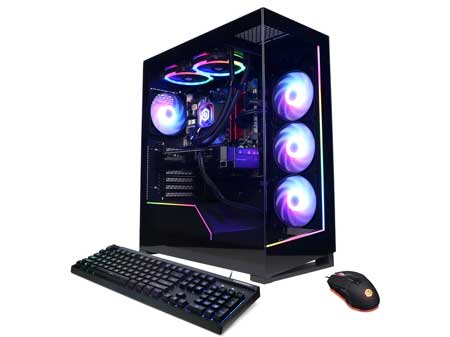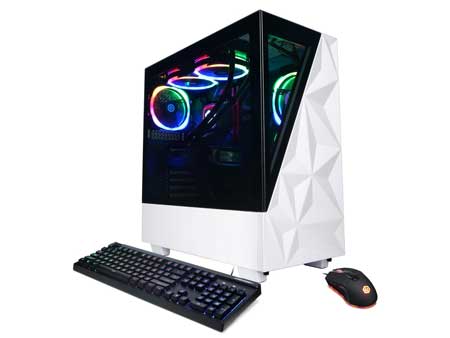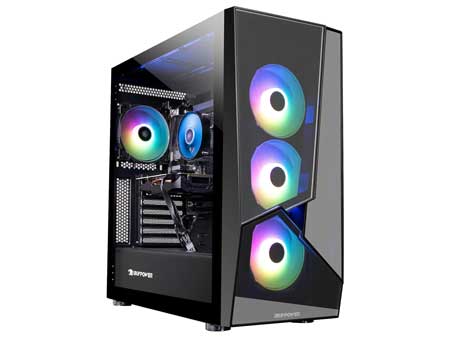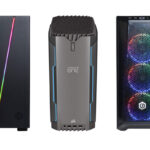We’ve written this guide for professionals in product development, mechanical engineering, and conceptual prototyping who demand high-performance computing for complex CAD models, 3D rendering, simulation, and real-time visualization. You rely on software like SolidWorks, Rhino, KeyShot, Alias, and Fusion 360, tools that require serious horsepower. If you work in industrial design, your desktop computer is an extension of your design process.
Creating products for real-world manufacturing involves precision modeling, parametric detailing, surfacing, and visualization workflows. These tasks challenge average systems with long redraw times, slow file operations, and instability during simulation or rendering.
Too many off-the-shelf desktops fall short. You’ll find consumer machines with gaming specs but no ECC memory support. Others have powerful GPUs but have limited airflow for thermal stability. Inconsistent IO speeds, insufficient memory channels, or misaligned CPU-GPU balances often introduce performance bottlenecks. In industrial design, those seconds and glitches stack up fast—wasting hours, reducing quality, and stifling output.
We focus here on desktop computers engineered for industrial design workflows. Machines that run CAD, rendering, and analysis software with speed, stability, and visual fidelity. These are desktops you can trust for mission-critical work, from first sketch to final render.
We evaluate each machine on six key criteria: Processor performance, Graphics capability, Memory configuration, Storage architecture, Thermal management, and Expandability. In addition, we establish the minimum hardware you should look for before you even start comparing brands.
Let’s define each feature and why it matters.
Processor performance is vital. Industrial design software typically leans on high single-core performance, especially in modeling and parametric recalculations. However, tasks like rendering or FEA simulation benefit from high core counts. Systems featuring Intel Core i9 or AMD Ryzen 9 chips with high base clock speeds help ensure responsiveness during modeling and faster throughput during rendering. This eliminates lags when manipulating assemblies or applying design constraints.
Graphics capability is equally important. Real-time visualization in KeyShot, GPU acceleration in Fusion 360, and complex shading in Alias demand a powerful workstation GPU. The NVIDIA RTX A-series or GeForce RTX 4070+ series bring CUDA cores, real-time ray tracing, and AI denoising. These features accelerate photoreal rendering, boost viewport responsiveness, and shorten iteration cycles—especially useful during design review or client presentations.
Memory configuration determines how well your machine handles multi-part assemblies, parametric history trees, and multiple applications open simultaneously. We recommend 64 GB of high-speed DDR4 or DDR5 RAM, especially if you’re toggling between CAD, rendering, and simulation tools. Low memory results in excessive paging, which slows down your workflow and can destabilize apps.
Storage architecture affects everything from boot time to how fast you can open your latest project archive. A primary NVMe SSD with at least 1TB capacity allows ultra-fast file access and smooth caching behavior. For large data sets, you may want a secondary SSD or HDD for archiving and backups. Solid-state drives also reduce latency during autosave, simulation cache generation, and texture loading.
Thermal management keeps performance consistent. Rendering or running simulation loads all cores for extended periods. Without proper cooling, CPUs throttle down to prevent overheating, which slows progress. We look for machines with well-ventilated cases, premium air coolers, or liquid-cooled solutions that maintain frequency stability under load. You want a machine that performs the same at 10AM as it does at 6PM.
Expandability allows your desktop to evolve. As software demands increase or your work shifts into VR or real-time visualization, your hardware should scale. We recommend systems with ample PCIe slots, extra M.2 storage ports, and at least a 750W power supply, ready to accommodate GPU upgrades or additional RAM. Investing in an expandable platform means you don’t have to buy a new system every two years.
Every desktop we’ve selected includes these minimum specs:
CPU: Intel Core i9 or AMD Ryzen 9 with 8+ cores, 3.5GHz base clock
GPU: NVIDIA RTX 4070 or RTX A4000 (or higher)
RAM: 64GB DDR4/DDR5
Storage: 1TB NVMe SSD primary, optional HDD/SSD secondary
Cooling: Premium air or AIO liquid cooling
Power Supply: 750W 80+ Gold certified or above
I/O: At least one USB-C port, multi-monitor support, and fast LAN/WiFi
This guide sets the stage for confident purchasing. We’ll walk you through desktops that deliver consistent CAD performance, fast render times, and stable multitasking.
Also check: best desktop pc for performance intensive programs in addition to the best desktop computer for Autodesk Inventor.
These are the Best Desktop Computers for Industrial Design:
Contents
- iBuyPower Pro Y60 Gaming PC Computer Desktop Y60BI9N4701 (Intel i9-13900KF 3.0 GHz, Nvidia GeForce RTX 4070 12GB, 32 GB
- iBUYPOWER Y40 Black Gaming PC Computer Desktop Y40BI7N48S01 (Intel Core i7 14700KF, RTX 4080 Super 16GB, 32GB
- CyberPowerPC Gamer Supreme Liquid Cool Gaming PC, AMD Ryzen 7 7800X3D 4.2GHz, GeForce RTX 4070 Ti Super 16GB, 32GB DDR5, 2TB PCIe Gen4 SSD
- CyberPowerPC Gamer Xtreme VR Liquid Cool Gaming PC, Intel Core i7-14700KF 3.4GHz, GeForce RTX 4070 Ti Super 16GB, 32GB DDR5, 2TB PCIe Gen4 SSD
- iBUYPOWER Pro Gaming PC Computer Desktop SlateMR 281a (AMD Ryzen 5 5600G 3.9 GHz, Nvidia Geforce RTX 3060 12GB, 16GB
iBuyPower Pro Y60 Gaming PC Computer Desktop Y60BI9N4701 (Intel i9-13900KF 3.0 GHz, Nvidia GeForce RTX 4070 12GB, 32 GB |
|
|---|---|
 See This On Amazon |
|
| CPU | Intel i9-13900KF |
| Processor Speed | 3.0 GHz |
| GPU | Nvidia GeForce RTX 4070 |
| Graphics Card Memory | 12GB |
| RAM | 32 GB |
| Storage Space | 1TB NVMe SSD |
| Operating System | Windows 11 |
| Dimensions | 18 x 11.2 x 18.2 inches |
| Keyboard & Mouse | Included |
| Computer Monitor | Sold Separately |
| Advantages | Performance |
| Disadvantages | Storage |
iBUYPOWER Y40 Black Gaming PC Computer Desktop Y40BI7N48S01 (Intel Core i7 14700KF, RTX 4080 Super 16GB, 32GB |
|
|---|---|
 See This On Amazon |
|
| CPU | Intel Core i7 14700KF |
| Processor Speed | 3.4 GHz |
| GPU | RTX 4080 Super |
| Graphics Card Memory | 16GB |
| RAM | 32GB DDR5 |
| Storage Space | 2TB NVMe SSD |
| Operating System | Windows 11 |
| Dimensions | 17.28 x 9.44 x 18.58 inches |
| Keyboard & Mouse | Included |
| Computer Monitor | Sold Separately |
| Advantages | Performance, Design, Build |
| Disadvantages | |
CyberPowerPC Gamer Supreme Liquid Cool Gaming PC, AMD Ryzen 7 7800X3D 4.2GHz, GeForce RTX 4070 Ti Super 16GB, 32GB DDR5, 2TB PCIe Gen4 SSD |
|
|---|---|
 See This On Amazon |
|
| CPU | AMD Ryzen 7 7800X3D |
| Processor Speed | 4.2GHz |
| GPU | GeForce RTX 4070 Ti Super |
| Graphics Card Memory | 16GB |
| RAM | 32GB DDR5 |
| Storage Space | 2TB PCIe Gen4 SSD |
| Operating System | Windows 11 |
| Dimensions | 23.2 x 22 x 13 inches |
| Keyboard & Mouse | included |
| Computer Monitor | Sold Separately |
| Advantages | Design, Build quality, Performance |
| Disadvantages | N.A |
CyberPowerPC Gamer Xtreme VR Liquid Cool Gaming PC, Intel Core i7-14700KF 3.4GHz, GeForce RTX 4070 Ti Super 16GB, 32GB DDR5, 2TB PCIe Gen4 SSD |
|
|---|---|
 See This On Amazon |
|
| CPU | Intel Core i7-14700KF |
| Processor Speed | 3.4GHz |
| GPU | GeForce RTX 4070 Ti Super |
| Graphics Card Memory | 16GB |
| RAM | 32GB DDR5 |
| Storage Space | 2TB PCIe Gen4 SSD |
| Operating System | Windows 11 |
| Dimensions | 22.5 x 22.5 x 13.25 inches |
| Keyboard & Mouse | Included |
| Computer Monitor | Sold Separately |
| Advantages | Good performance |
| Disadvantages | None |
iBUYPOWER Pro Gaming PC Computer Desktop SlateMR 281a (AMD Ryzen 5 5600G 3.9 GHz, Nvidia Geforce RTX 3060 12GB, 16GB |
|
|---|---|
 See This On Amazon |
|
| CPU | AMD Ryzen 5 5600G |
| Processor Speed | 3.9 GHz |
| GPU | Nvidia Geforce RTX 3060 |
| Graphics Card Memory | 12GB |
| RAM | 16GB DDR4 |
| Storage Space | 500GB NVME SSD |
| Operating System | Windows 11 |
| Dimensions | 18.9 x 8.66 x 19.3 inches |
| Keyboard & Mouse | Included |
| Computer Monitor | Sold Separately |
| Advantages | Design, Build, Value |
| Disadvantages | Storage |
RELATED ARTICLES:
Latest Top Desktop Computer for MATLAB





